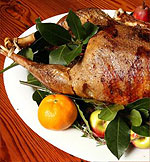Roast goose recipe
Goose is best for Christmas, served with mashed potatoes, petits pois and apple sauce


Goose versus turkey: goose is best, I believe. I serve it with mashed potatoes, frozen petits pois and apple sauce. If you must have a stuffing, chop up soft, stoned prunes with eating apples and raisins and shovel them into the cavity, remembering to add this to the total weight. Take out all the fat inside the cavity and render it down in a slow oven for later use (think roast potatoes). Prick the goose’s skin all over and shake a little salt on. Use a roomy roasting tin, as more fat will come off during cooking.
Roasting your goose
Heat your oven to 220˚C and roast the goose for 30 minutes. Then turn it down to 170˚C and roast it for 20 minutes per pound. If it’s not brown enough, turn up the heat. For an Aga, roast it in the hot oven for 2½ hours for a 9lb goose and three hours for a 10lb–11lb one. Allow the bird to rest for 30 minutes before carving. Cold roast goose is delicious with more apple sauce and potatoes roasted in the surplus fat.
Sauce for the goose
Although it has more flavour than roast turkey, goose lacks the gamey notes of pheasant or partridge. What sets it apart is its natural fat that melts into the flesh and gives us luscious gravy, thus creating an indulgent dish. This means any vinous partner needs to mirror this form bold in fruit and flavour, but with enough structure to handle its intensity. Some reach for the nearest bottle of Pinot Noir or aged Syrah, but, for me, the perfect spouse for a goose will always be a particular breed of white wine aromatic, yet rich and masterful.
The best wine needs some gravitas behind it, and that’s what you find in 2006 Pierro Chardonnay Margaret River, Western Australia. Margaret River has the benefit of tons of sunshine, but the heat is tempered by cool ocean winds that give a Meursault-like wine, with more amplitude and daring. Alternatively, Chester Osborn, the colourful winemaker behind d’Arenberg in McLaren Vale, conjures up a radically different take on this theme, instead utilising Viognier and Marsanne in the 2006 d’Arenberg, The Hermit Crab. Marsanne brings nuances of hazelnuts, as well as a honeyed perfume, and Viognier adds fleshier notes of quince and apricot.
For the committed Franco-philes, Chapoutier blends white Grenache, Clairette and Bourboulenc in the 2007 Côtes du Rhône Belleruche Blanc, which has similar nutty characteristics. However, as you’d imagine, the wine has more linear acidity, and the fruit leans toward apricot kernels and almond blossom. These wines have the intensity of fruit and balancing acidity that roast goose requires, but the real bonus is the surprise you bring to the table when you serve white wine with a dish that most people associate with red.
Sign up for the Country Life Newsletter
Exquisite houses, the beauty of Nature, and how to get the most from your life, straight to your inbox.
Country Life is unlike any other magazine: the only glossy weekly on the newsstand and the only magazine that has been guest-edited by HRH The King not once, but twice. It is a celebration of modern rural life and all its diverse joys and pleasures — that was first published in Queen Victoria's Diamond Jubilee year. Our eclectic mixture of witty and informative content — from the most up-to-date property news and commentary and a coveted glimpse inside some of the UK's best houses and gardens, to gardening, the arts and interior design, written by experts in their field — still cannot be found in print or online, anywhere else.
-
 Helicopters, fridges and Gianni Agnelli: How the humble Fiat Panda became a desirable, design classic
Helicopters, fridges and Gianni Agnelli: How the humble Fiat Panda became a desirable, design classicGianni Agnelli's Fiat Panda 4x4 Trekking is currently for sale with RM Sotheby's.
By Simon Mills
-
 What's a 'wellness village' and will it tempt you back into the office?
What's a 'wellness village' and will it tempt you back into the office?The team behind London's first mixed-use ‘wellness village’ says it has the magic formula for tempting workers back into offices.
By Annunciata Elwes